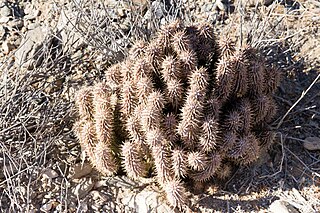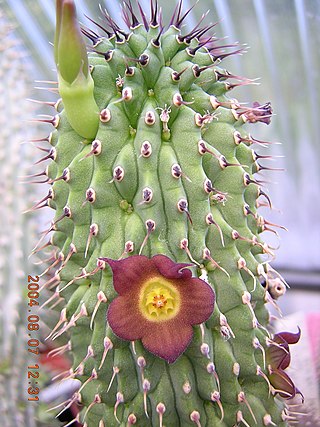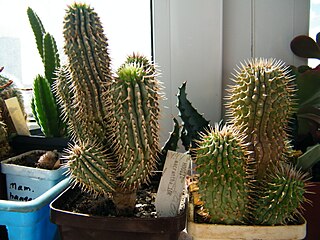
Apocynaceae is a family of flowering plants that includes trees, shrubs, herbs, stem succulents, and vines, commonly known as the dogbane family, because some taxa were used as dog poison Members of the family are native to the European, Asian, African, Australian, and American tropics or subtropics, with some temperate members. The former family Asclepiadaceae is considered a subfamily of Apocynaceae and contains 348 genera. A list of Apocynaceae genera may be found here.

Lythrum salicaria or purple loosestrife is a flowering plant belonging to the family Lythraceae. It should not be confused with other plants sharing the name loosestrife that are members of the family Primulaceae. Other names include spiked loosestrife and purple Lythrum. This herbaceous perennial is native to Europe and Asia, and possibly Australia.

Hoodia is a genus of flowering plants in the family Apocynaceae, under the subfamily Asclepiadoideae, native to Southern Africa.

The curry tree, Murraya koenigii or Bergera koenigii, is a tropical and sub-tropical tree in the family Rutaceae, native to Asia. The plant is also sometimes called sweet neem, though M. koenigii is in a different family to neem, Azadirachta indica, which is in the related family Meliaceae.

Andromeda polifolia, common name bog-rosemary, is a species of flowering plant in the heath family Ericaceae, native to northern parts of the Northern Hemisphere. It is the only member of the genus Andromeda, and is only found in bogs in cold peat-accumulating areas.

Prosopis glandulosa, commonly known as honey mesquite, is a species of small to medium-sized, thorny shrub or tree in the legume family (Fabaceae).

Hoodia gordonii, also known as Bushman’s hat, is a leafless spiny succulent plant supposed to have therapeutic properties in folk medicine. It grows naturally in Botswana, South Africa and Namibia. The species became internationally known and threatened by collectors, after a marketing campaign falsely claimed that it was an appetite suppressant for weight loss. The flowers smell like rotten meat and are pollinated mainly by flies. The indigenous San people of the Namib desert call this plant ǁhoba is used to refer to all species of Hoodia.

Botanic Gardens Conservation International (BGCI) is a plant conservation charity based in Kew, Surrey, England. It is a membership organisation, working with 800 botanic gardens in 118 countries, whose combined work forms the world's largest plant conservation network.

Gonialoe dinteri, the Namibian partridge aloe, is a species of flowering plant in the Asphodelaceae family. It is native to arid areas of Angola and Namibia.

Hoodia juttae is a species of plant in the family Apocynaceae. It is endemic to Namibia. Its natural habitats are rocky areas and cold desert. H. juttae is found around the Little and Great Karas mountains. It is threatened by collection. The plant was discovered by Jutta Dinter, the wife of botanist, Kurt Dinter in 1913. The scientific name refers to Jutta.
Hoodia triebneri is a species of plant in the family Apocynaceae. It is endemic to Namibia. Its natural habitat is rocky areas, especially underneath Acacia trees and below ridges.
Hoodia flava is a succulent native to the Cape Province in South Africa and to Namibia. It has a unique pattern of distribution, growing inside bushes or on gravelly slopes and hills. It is commonly known as ghaap or yellow-flowered ghaap in the Afrikaans language.

Piaranthus is a succulent plant genus in the subfamily Asclepiadoideae, in the family Apocynaceae.

Hoodia alstonii is a succulent plant native to Namibia and the Cape Province of South Africa. H. alstonii is also known commonly as ghaap, an Afrikaans name. It tends to grow in rocky, desert areas.

Hoodia officinalis is a succulent plant native to Namibia and the Cape Province of South Africa. H. officinalis has two officially recognized subspecies, H. officinalis subsp. officinalis and subsp. delaetiana, which are identified mainly by their distribution. Subsp. delaetiana grows only in the Klinghardt Mountains and are larger than subsp. officinalis.

Hoodia macrantha is a succulent plant native to Namibia and the Cape Province of South Africa. It is regarded by some sources as a synonym of the accepted name for the plant, Hoodia currorii subsp. currorii.

Hoodia currorii is a succulent plant native to Namibia and the Cape Province of South Africa. It grows in desert areas and is common along the road from Karibib to Swakopmund in Namibia. It is also known as ghaap in the vernacular.
Iris adriatica is a plant species in the genus Iris, it is also in the subgenus Iris. It is a rhizomatous perennial, from the Dalmatia region of Croatia in Europe. It has short sickle shaped leaves, small stem and flowers that vary from yellow to purple or violet. It is rarely cultivated as an ornamental plant in temperate regions.

Iris marsica is a plant species in the genus Iris, it is also in the subgenus Iris. It is a rhizomatous perennial, from the Apennine Mountains, in Italy. It has glaucous, sickle-shaped or curved, light green leaves, slender stem with 2 branches, and 3 violet, light blue violet, dark violet, and dark purple flowers. It was only found and described since 1973, and is not yet in general cultivation. It was once thought to be a form of Iris germanica, but has different morphological characteristics and different chromosomal differences.
Iris timofejewii is a species of flowering plant in the genus Iris, and also in the subgenus Iris. It is a rhizomatous perennial, from the mountain slopes of the Caucasus and Dagestan. It has narrow, evergreen, falcate (sickle-shaped), grey-green (glaucous) leaves, and a short flowering stem just taller than the leaves. Each stem has 1–2 flowers in shades of violet, with white beards that have purple tips. It is cultivated as an ornamental plant in temperate regions.
















